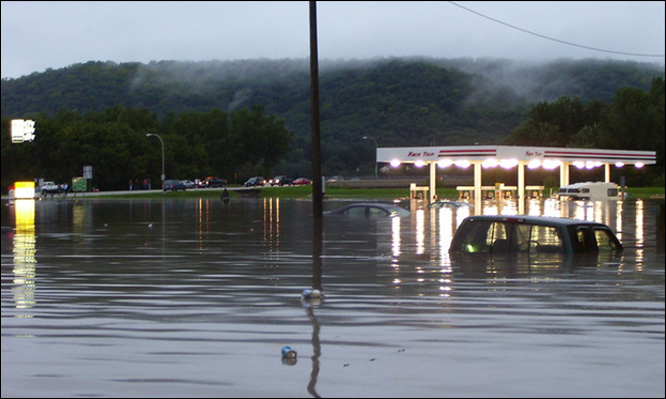
Matt Doll, Minnesota Environmental Partnership
Most people in Minnesota have heard the famous phrase about our weather patterns. “We have two seasons, winter and road construction.” It’s not literally true, of course, but it feels that way, with snowstorms showing up for the first taste of winter in October and the last in May.
Though it gets less popular attention, the inverse – our hot summers – is also true. We often hear another saying: “It’s not the heat, it’s the humidity.”
We joke about the weather because it’s a shared experience, and because our weather is indeed weird. The famous Halloween blizzard that blanketed the Twin Cities happened before I was born, but I can’t count the number of times I’ve heard about it since living here.
With a changing climate, our weather is getting stranger. As one of the fastest-warming states, Minnesota is vulnerable to big changes, changes so visible that climate science denial seems more purposefully ignorant than ever.
Right now, floodwaters are finally receding on Rainy Lake on Minnesota’s northern border. Throughout June and early July, hundreds of residents have suffered from flooding.
“Property owners have seen damage that will take years to repair, businesses have stalled or will be in financial straits at the end of the season,” said International Falls resident Megan Bond. “We live in a northwoods paradise and it is being slowly eaten by the effects of frequent, severe weather conditions caused by the climate crisis.”
Other waters have been high, though for most of the state, flooding hasn’t been as bad as it was in the spring of 2019. That year, the valleys of the Red, the Minnesota, the Mississippi, and the St. Croix all experienced floods. Communities from Moorhead to Stillwater piled up sandbags as water inundated roads and farmland.
Last year, on the other hand, Minnesota faced the worst drought in decades. Vast swaths of grass and crops went dry, hitting farmers especially hard. It’s for that reason the Legislature passed funding in the Ag bill for grants to affected farms, up to $7500 per farmer. International Falls wasn’t spared either: according to Bond, “We experienced a record dry year with wildfires burning so badly our air quality was worse than Los Angeles in the ‘80s.”
After the drought, of course, Minnesota ended the year with our first-ever recorded December tornado.
Historically, it’s been tricky to determine how much of any given weather event is due to our changing climate. Fortunately, scientists have made big strides forward on making it easier to make the cause and effect clearer.
Regardless, we know that more heat waves, storms, droughts, and wildfire smoke are making Minnesotans’ lives worse. They’re not doing so equally, either: it’s well-established that communities of color that have suffered a history of segregation tend to suffer hotter temperatures, even within the same city.
What’s the next step?
The real question is not whether climate change is impacting Minnesota’s weather, making it weirder and worse. Our changing temperatures will have dire consequences for people and wildlife adapted to cooler temperatures. What we need to decide now is what to do about it.
For the answer, we need to build up clean energy and do away with dirty energy. As Bond put it to me, “We need to stop pulling fossil fuels out of the Alberta tar sands. We need more wind energy throughout the state. We need to safeguard the protected lands and waters in the Rainy Lake Basin. ”
Around the state, we need density in cities and restored habitat in natural spaces. We need green infrastructure to mitigate floods and more trees, especially in environmental justice communities, to mitigate heatwaves. Conversely, we need to stop expanding highways and focus on more transit and more safety for cyclists and pedestrians. And in everything we do, we must listen to low-income and communities of color most impacted by climate change and pollution.
Recent legislative efforts are a start, but we need to do a lot more. If we’re unsuccessful, future generations will reap the whirlwind. But if we commit to real climate action, we’ll improve our health, create jobs and economic growth, save us billions of dollars in direct climate change damages and protect our natural resources from more damage. Minnesota can be an example for the world to follow – and a better place for all of us to live.
For previous columns, visit mepartnership.org/category/blog/. If you would like to reblog or republish this column, you may do so for free – simply contact the author at matthew@mepartnership.org.